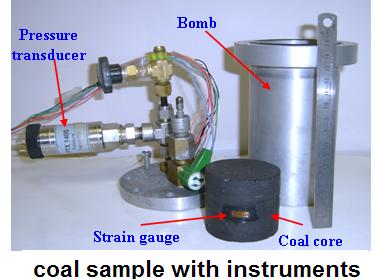|
Coal swells and shrinks with gas sorption (adsorption and desorption),
the extent of the changes in coal is influenced by gas type and pressure.
Volumetric changes in coal are attributed to both coal matrix change and
the changes in cleats, fissures and other fractures in coal. These changes
are dependent upon the coal rank, maceral structure of coal, the degree
of mineralisation, geological disturbances and intrusions.
Volumetric changes in coal have a profound effect on
coal permeability and porosity.The figure opposite shows the relative volumetric
changes
in Bulli seam coal from West Cliff colliery ,N.S.W, Australia.
The coal samples were tested for different gases under different gas pressures
up to 3 MPa.
The tests are usually carried out in a pressure vessels under controlled
conditions as shown in the figure below.
The appropriate way of expressing volumetric changes in coal is by shrinkage
coefficient, which is defined as the rate of change of the coal matrix
volume to the change in gas pressure and is given by:

Vm = Matrix volume, m3
dVm = change in volume, m3
dP = change in applied pressure, MPa
Cm = shrinkage coefficient, MPa-1

Carbon dioxide appears to have the greatest influence
on the matrix and nitrogen the least. This is understandable in view of
the fact that carbon dioxide has a greater affinity to coal than the other
gases.Nitrogen as a neutral gas does not have much effect on the coal volume.
contd.. |